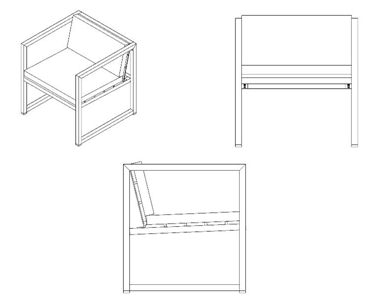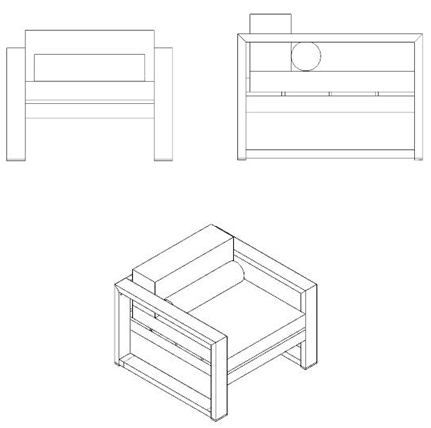Eigen karakter stoel en tuinstoel
Gerecht EU 4 februari 2014, zaak T-339/12 (Fauteuil cubique) - dossier ; zaak T-357/12 (Fauteuil) - dossier  Gemeenschapsmodel – Beroep tot vernietiging van beslissing kamer van beroep van het Bureau voor harmonisatie binnen de interne markt (BHIM) houdende verwerping van het beroep tegen de beslissing van de nietigheidsafdeling tot afwijzing van de vordering tot nietigverklaring die door verzoekster is ingesteld tegen gemeenschapsmodel nr. 1512633-0001 (Fauteuils).
Gemeenschapsmodel – Beroep tot vernietiging van beslissing kamer van beroep van het Bureau voor harmonisatie binnen de interne markt (BHIM) houdende verwerping van het beroep tegen de beslissing van de nietigheidsafdeling tot afwijzing van de vordering tot nietigverklaring die door verzoekster is ingesteld tegen gemeenschapsmodel nr. 1512633-0001 (Fauteuils).
 Gemeenschapsmodel. Beroep ingesteld door de houder van gemeenschapsmodel nr. 1512633-0003 (Fauteuils) en strekkende tot vernietiging van beslissing van de kamer van beroep van het Bureau voor harmonisatie binnen de interne markt (BHIM) van 27 april 2012 houdende vernietiging van de beslissing van de nietigheidsafdeling tot afwijzing van de door Gandia Blasco SA ingestelde vordering tot nietigverklaring. Beiden beroepen worden afgewezen.
Gemeenschapsmodel. Beroep ingesteld door de houder van gemeenschapsmodel nr. 1512633-0003 (Fauteuils) en strekkende tot vernietiging van beslissing van de kamer van beroep van het Bureau voor harmonisatie binnen de interne markt (BHIM) van 27 april 2012 houdende vernietiging van de beslissing van de nietigheidsafdeling tot afwijzing van de door Gandia Blasco SA ingestelde vordering tot nietigverklaring. Beiden beroepen worden afgewezen.
57. Consequently, even though the Board of Appeal could correctly take into account as an element of similarity the fact that the seats of the armchairs represented in the designs at issue were composed of juxtaposed rectangular plates, that barely visible element is of little importance to the assessment of the overall impression produced by the contested design.
58. Fourthly, the applicant claims, wrongly, that the presence of a board below the plates on either side of the armchairs is called for by stability and structural requirements. Suffice it to point out that, in the present case, the Board of Appeal rightly found that the freedom of the designer was limited only by the fact that the armchairs have to be functional and include a seat, a backrest and two armrests. The applicant has not established that the presence of that board was a consequence of a technical constraint in constructing an armchair and the fact that many armchairs do not contain that board contradicts the applicant’s claim.
59. Fifthly and lastly, the applicant’s argument that the Board of Appeal stated, incorrectly, that the armrests of the armchairs were on the same level as the upper limits of the backs [of the armchairs] and that they were linked to them must be rejected. As stated in paragraph 46 above, it is clear from the designs at issue that the armrests of the armchairs are linked to the backs [of the armchairs], which is a structural element they have in common, and that only the cushion extends above the back of the armchair represented in the contested design.
60. It follows from the foregoing that the applicant has not shown that the Board of Appeal erred in its assessment of the elements of similarity between the designs at issue, nor, consequently, in finding that the designs at issue produced the same overall impression on the informed user. Accordingly, the applicant’s third complaint must be rejected.
Uit zaak T-357/12 (Fauteuil) - dossier
22. The applicant claims, in essence, that the designs at issue produce the same overall ‘cube’ impression and that the differences between them relate to immaterial details only.
27. The effect of the difference in the shape of the frame (rectangle and square) and in the height of the seat is that the designs at issue differ in their proportions. The applicant is therefore wrong to claim that the designs at issue produce the same impression of a ‘perfect cube’.
30. In view of the case-law cited in paragraph 26 above, according to which the overall impression produced on the informed user must necessarily be determined in the light of the manner in which the product in question is used, account must be taken of the difference between the designs at issue as regards the angle of the backrest and the seat of the armchair represented in the contested design. Since an inclined backrest and seat will give rise to a different [level of] comfort from that of a straight back and seat, the use that will be made of that armchair by the circumspect user is liable to be affected thereby.
39. First, the applicant claims that, taking account of the very high degree of freedom of the designer, it is difficult to comprehend why the features of the contested design should be so similar to those of the earlier design, [the features of] which differentiate [the earlier design] from pre-existing armchair designs. The applicant submits that protection requires a creative effort that results in an object with an original and different appearance. The applicant claims, in essence, that the designer of the contested design reproduced the original idea of the earlier design, altering certain insignificant details only.
40. It is true, as the Board of Appeal has pointed out, that the possibilities for the design of an armchair are almost unlimited: the designer’s freedom may be applied to colours, patterns, shapes and materials. Nevertheless, it has been found, in paragraph 36 above, that the contested design differed from the earlier design, from the point of view of the informed user, in significant, not inconsiderable features concerning the appearance of the armchairs. The contested design cannot, therefore, be regarded as a reproduction of the earlier design or of the original idea that was developed for the first time in that earlier design.
41. Secondly, the applicant invokes two earlier OHIM decisions in which OHIM granted the applicant’s applications for a declaration that designs for armchairs registered by the intervener were invalid.
42. In this connection, it should be pointed out that the decision of the Invalidity Division and the decision of the Board of Appeal invoked by the applicant related to invalidity proceedings concerning designs other than the designs at issue in the present case and that the legality of the decisions of Boards of Appeal must be assessed solely on the basis of Regulation No 6/2002, as interpreted by the Courts of the European Union, and not on the basis of a previous decision-making practice of OHIM.
























































































